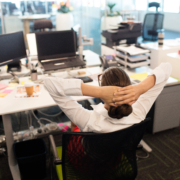Singapore: Bursting the hybrid working bubble?
While we are getting comfortable settling into the routines of working from home, there is now news that work from home will no longer be the default from 1 Jan 2022 onwards. On December 14, The Ministry of Health made an announcement that 50% of the employees who can work from home will be allowed to return to the office from the start of January. Of course, these measures only apply to employees who are fully vaccinated or have recovered from Covid-19 recently.
Whether this piece of news is worth to be celebrated over, it remains unclear. There are sentiments surrounding both sides of the coin; some employees are lamenting over it since work from home has granted them with great advantages, while some employers are cautiously happy about returning to that form of normality.
After all, there are many existing limits to the whole work from home set up. Some of the struggles of navigating remote working can be very subjective as well, such as not having a conducive enough environment at home for work. Especially when meetings and discussion of confidential information surface, remote working does provide an added challenge for employees who face space constraints problems.
With these employees, there are some consensuses around that moving back to the office can be better in terms of reduced ambiguities with in-person meetings and the authentic social interaction with colleagues as well.
However, Singaporeans may not be entirely ready to give up the added advantages of working from home. Some of the cited advantages are lesser time wasted during commute, extra sleep, higher flexibility, and the list goes on. Especially for employees who have children at home, this remote working arrangement has seen to be more productive for some.
An Organizational behavior expert – Associate Professor Trevor Yu – commented that it remains vital that employers and employees work out a set of flexible work arrangements that is satisfactory for all key stakeholders.
Amongst the factors of consideration, it is necessary to understand the best conditions the employees work under. Adapting back into the “normal” routine of going back to offices can be a sudden change for many, and while the benefits of returning back are recognized, employees’ safety and headspace should take precedence. After all, going back to offices does not mean returning to pre-Covid arrangements; mandatory mask-wearing policies, regular temperature logging and safe distancing measures will still be in place. All these are added factors that can be uncomfortable for employees, which may impact productivity in the end.
Ultimately, as Singapore progresses towards recovery, Singaporeans should still prepare to ease back into returning to offices. Employers, however, can better facilitate this shift and adaptation by gathering employees’ sentiments and understanding any legitimate concerns that some employees may have and actively provide a solution to help those employees transition back to normality.
References:
https://www.channelnewsasia.com/singapore/wfh-return-office-default-working-home-companies-2383286
https://www.channelnewsasia.com/singapore/singapore-working-from-home-office-covid-19-604441
https://www.channelnewsasia.com/singapore/work-home-return-office-1-jan-vds-2378516



